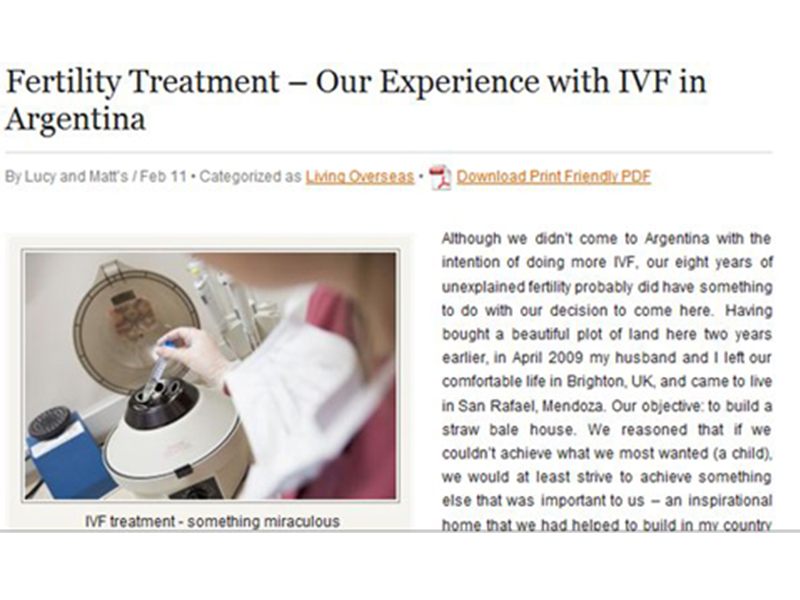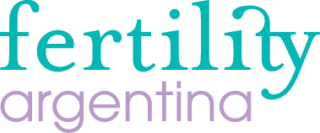Fertility Treatment – Our Experience with IVF in Argentina.

EFAM – Escape from America Magazine
By Lucy and Matt’s / Feb 11.
Although we didn’t come to Argentina with the intention of doing more IVF, our eight years of unexplained fertility probably did have something to do with our decision to come here. Having bought a beautiful plot of land here two years earlier, in April 2009 my husband and I left our comfortable life in Brighton, UK, and came to live in San Rafael, Mendoza. Our objective: to build a straw bale house. We reasoned that if we couldn’t achieve what we most wanted (a child), we would at least strive to achieve something else that was important to us – an inspirational home that we had helped to build in my country of birth, Argentina.
The alternative, as we saw it, would have been to spend what remained of our savings on more IVF after having already had the heartache of 3 unsuccessful IVF cycles in the UK, and 3 IUI cycles before that. The specialists had never been able to diagnose what was wrong, though something clearly was.
We felt we’d tried everything, conventional and alternative, and the infertility was truly unexplained. I had a vague thought that maybe something would miraculously «happen» if we changed focus and went off to build our house in Argentina. I wondered if I could possibly fall pregnant naturally, away from the stresses of my job (in a non-profit organisation dedicated to family planning, ironically enough). I wondered whether we might stumble on a baby for adoption, and we did start looking into the process, only to be told the average wait for a young child would be six years. Anyway, for the first six months we were extremely busy and did not have too much time to think about this issue that seemed to have dominated my life since the age of 31 when we started trying to conceive. I was then 39.
Something did miraculously «happen» – but utterly not what we were expecting. A new friend of ours, a beautiful and charismatic young woman from San Rafael (we’ll call her V), told me at a Halloween party that she had dreamt that she had had a baby for me, and that she wanted me to know she’d be willing to help if we ever needed. We couldn’t have known her for more than four months at this point, and, what with the alcohol flowing at the party, I didn’t for a second think this was serious, sweet though it was. What amazed me was the following morning waking up with a new sense of hope and willingness to try IVF again, but this time with egg donation. We had briefly considered and then rejected this option in the UK. I had two sisters but the older one was considered too old, and there were too many emotional issues involved with my younger sister, then single. Then there was the expense (around 12,000 Euros or USD $ 19,000) and the success rate of only 40%. We just didn’t relish the 60% odds of spending that just for another disappointment. And, being perfectly honest, going through a clinic who sent you to the Ukraine for your embryo transfer just seemed rather cynical, though I have changed my views on that since.
A few days later V brought up the subject again and told me she had been completely serious. We were amazed and delighted but asked her to think more about it and discuss it with her partner and then we could talk about it again. We were seeing egg donation in a new light as it seemed incredible that someone would offer such a gift in such a selfless way. She already had a child herself and was motivated purely by the desire to help someone else experience this joy.
After some more discussion, and researching where we could do the treatment, we found out that by law egg donation in Argentina had to be anonymous and we were not going to be able to do it with V. If we really wanted to, we could have gone to Colombia, but apart from being impractical, we realised it was unnecessary. We had come to the conclusion that perhaps an anonymous donor was best for everyone. V’s role had been to get us to reconsider this option and get us thinking positively again. In the course of our research, we came across the Centro de Estudios en Ginecologia and Reproduccion(http://www.fertilityargentina.com) in Buenos Aires and the egg donation programme run by Dr Demian Glujovsky. I remember my excitement when he answered my email enquiry the same day and asked me when we wanted to start a cycle. Suddenly it became real and my husband and I decided we would go for it.
The information in English on the website was very clear and answered all our questions. The pricing was transparent and IVF with egg donation was very good value at USD $5,000. The website provided full information on what would be involved as an egg recipient and what drugs /scans/blood tests I would need.
Although I wasn’t sure exactly how the logistics would work as I would not be in Buenos Aires, Dr Glujovsky reassured us that we could do most of the cycle remotely and we would only need to spend a matter of days in Buenos Aires. In fact they cater specifically to overseas clients, mostly in the US.
The cycle started with taking a cycle of contraceptive pills (to suppress my own cycle). We then went for an appointment at the CEGYR as we happened to be in Buenos Aires, although for US clients they can have their initial appointment in the US with a liaison person there. We were told that the good news with egg donation was that most couples conceived within two or sometimes three cycles. This was different to the normal disclaimers that we were only 25% likely to conceive.We had some blood tests done in Buenos Aires and confirmed (again) that neither of us had HIV or syphilis. I had to have a few additional tests as I was by then 40, and then we were ready to proceed. Compared with the daily injections needed for normal IVF, with egg donation I needed only one intramuscular injection, which I could get done at the local clinic in San Rafael. This was a slightly tricky part as we had to buy the drug in Buenos Aires, keep it cold on the bus back to San Rafael and until it was needed on a given day. This drug was a relatively expensive part of the process, and not readily available in the pharmacies of San Rafael. It had an amazingly complicated assembly mechanism which involved attaching two glass vials which did not seem to want to be attached. As I watched the nurse struggle with it, then call in the doctor to help, lying on my stomach with my pants hitched down to expose my gluteals, I had visions of the thing breaking and spilling over the floor, and wiping out our cycle for that month. Luckily this did not transpire and the clever doctor found a way around the darn thing.
With modern technology we were able to get the two vaginal ultrasounds needed done in San Rafael and the results scanned and emailed to Dr Glujovsky. From these results he could tell me when to start taking the next lot of drugs – thankfully all in tablet form – and when we should plan to travel to Buenos Aires.
We didn’t receive much (well any) information about the egg donor, but neither did we want to. We were asked to send photos of ourselves to help with the matching, and of course sent the most flattering ones we could find. I was happy to think of the donor as an amazing and brave person willing to give us this gift but didn’t need to know any personal details about her. On the day of egg collection I worried about her a little and hoped she was okay.
We travelled to Buenos Aires ready for the embryo transfer three days later. Compared to the UK, where they just ask you to turn up for this procedure wearing a skirt, so they can get you on and off the gynae table with minimum fuss, the procedure here was rather more medicalised. It involved me changing into a full gown and cap, and my husband was also asked to dress up like a character in ER – though this was kind of fun.
The first cycle sadly did not work. I was so used to disappointment by then I was not as crushed as my husband. We spent a couple of months licking our wounds before reasoning that with a 50% success rate, it would be silly not to have a second go, just so we got to the end of this road and at least knew we’d given it a fair shot. So off we went again, even easier this time as we’d done it all before and knew the ropes. With the house building, we were certainly not flush with funds by then, but we were willing to try this one last time.
The day before we took the blood test I told my husband that it hadn’t worked again as I was sure I was starting a period. He was devastated and we went to get the blood test results together feeling very low. We were so convinced of bad news I had to call Dr G on his mobile to check what a level of 70 HCG actually meant. «Congratulations – you’re pregnant» is what he said before I burst into tears, followed soon after by my husband.
I am now eighteen weeks pregnant and so far so good. We heard the heart beat for the first time at six weeks which was incredible, and saw the little bean transform into an alien, and finally into a human shape by twelve weeks. Now my tummy is beginning to bulge and we’re incorporating a built in baby bed in our new bedroom we have just moved into. These are very happy days when our two dreams – baby and house – are both happening. If any other couple out there is considering travelling to Argentina for fertility treatment, or egg donation, I would recommend it.
Matt’s comments:
As Lucy has explained, we did not come to Argentina thinking of going through more fertility treatment. Six attempts were more than enough when you have to deal with the emotional pain of a failure to conceive. Still, I had not given up on the chance of getting pregnant and while we had discussed egg donation in the past it was not a financial viability for us in Europe.
The most difficult mental hurdle to overcome was that of using another person’s genetic material, but once we realized what an amazing gift this was, it became a no brainer. Lucy would nurture the embryo and carry it to term and I would have the customary five minutes interaction to provide the sperm, though this time in a small, quiet room by myself.
The process was much easier than it had been doing regular IVF. We were in constant contact with our Doctor (Dr. G) and besides supporting Lucy and being by her side, all I did was provide the sperm sample. This was relatively easy though they did want it produced on site at the clinic. It would also have been possible to provide a sample in advance to freeze if I had been unable to attend on the day of egg collection. To this end I was escorted to a small private room away from any other activity in the clinic by a dapper concierge-security gentleman. Between his limited English and my limited Spanish, I understood where the sample needed to be delivered and how to fill out the label. There was plenty of reading material and videos for my edification, plus, on our second cycle, we decided it would be more fun if Lucy accompanied me and the concierge didn’t seem to object.
The actual transfer of embryos was fast, professional and painless (except for Lucy’s full bladder) and the nurse, embryologist and Dr. G all spoke good English. We were talked through the process and were able to see the embryos in a microscope prior to transfer. After the transfer the vial was checked to ensure the embryos made it out.
Unfortunately our first round did not work, but with this process there is a 45-50% chance of conceiving each cycle. As much as it hurt when we failed I wanted to give us every opportunity to conceive and see this process through. So we tried again.
Thankfully on the second try it worked.![]()




